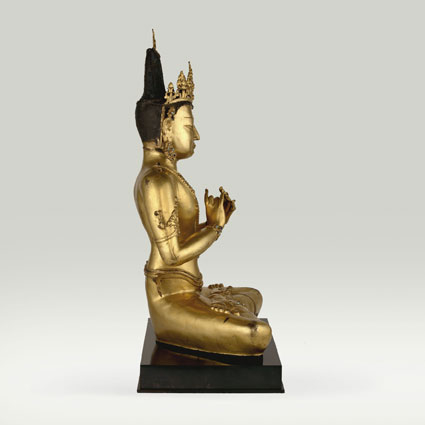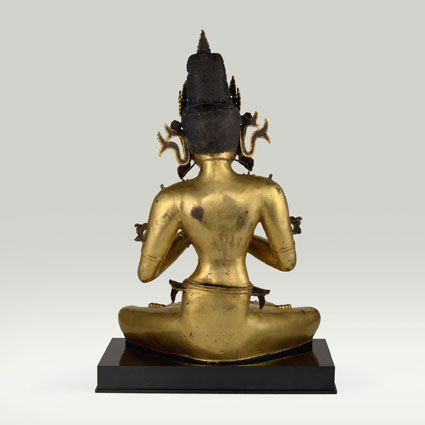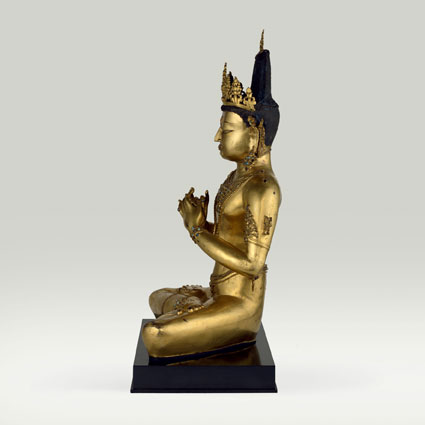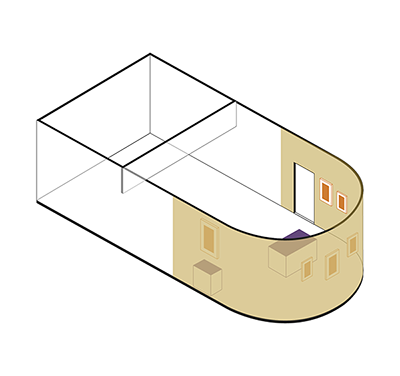ABS 174
Code: ABS 174
Country: Tibet
Style: Nepalese School
Date: 1200 - 1300
Dimensions in cm WxHxD: 41 x 68 x 23.1
Materials: Gilt copper alloy
Hollow cast in several parts and assembled.
The elaborately worked jewel ornaments are inset with turquoise, coral, lapis lazuli, and rock crystal.
This gilt copper image very likely represents Manjughosa (Tib. 'Jam pa 'i dbangs) - a form of Manjusri (Tib. 'Jam dpal) - depicted as crowned and bejeweled Bodhisattva in the sambhogakaya aspect. The Bodhisattva, slightly bent at the hip and neck, is seated in the diamond attitude (vajraparyankasana), and was originally placed on a separately cast lotus pedestal. The hands form the "gesture of the wheel of the doctrine" (dharmacakra-mudra). He is clad in a cloth tied by a belt around the hips. He has bejeweled ornaments, namely a five-leaved crown, two necklaces with attached pendants, bracelets on the upper arms and wrists, ankles, and feet. The emblem on the forehead is possibly a ratnayupa. The hands originally held the stalk of a flower which, according to the sadhanasof Manjusri, should represent the blue lily (nilotpala); it was attached to the shoulders and decorated with a pair of attributes.
This large Manjughosa was likely manufactured in Tibet during the 13th century by a Newar artist from the Kathmandu valley. Note the influence by Pala sculptures.
Provenance
Formerly at the Cranmore Ethnological Museum, Chislehurst, Kent U.K. Founded by Harry G. Beasley (1882-1939). There is a possibility that this image was brought to England from Tibet by one of the Younghusband expedition (1903-1904).
(From Wikipedia, the free encyclopedia)
Manjushree, also written Manjushri, is the bodhisattva of keen awareness in Buddhism. A disciple of the historical Buddha Shakyamuni, he represents wisdom, intelligence and realisation, and is one of the most popular Bodhisattvas following Avalokitesvara (Ch: Guan Yin).
Together with Shakyamuni and fellow disciple Samantabhadra he forms the Shakyamuni trinity (Jp: Sanzon Shaka). Manjusri is one of the Eight Wisdom Bodhisattvas and one of the Japanese Thirteen Buddhas. In Tibetan Buddhism he sometimes is depicted in a trinity with Avalokiteshvara and Vajrapani.
Manjusri is mentioned in many Mahayana sutras, particularly the Prajnaparamita Sutras. The Lotus Sutra assigns him a paradise called Vimala, which according to the Avatamsaka Sutra is located in the east. His consort in some traditions is Saraswati. He is also sometimes called Manjughosha.
Within Tibetan Buddhism, Manjushri is a tantric meditational deity or Yidam, and considered a fully enlightened Buddha.
Manjusri Mantra
Chanting the Manjusri Mantra "Om Ah Ra Pa Tsa Na Dhih" is believed to enhance wisdom and improve one's skills in debating, memory, writing, explaining etc. "Dhih" is the seed syllable of the mantra and is chanted with greater emphasis.
A male Bodhisattva, he is depicted wielding a flaming sword in his right hand, representing his realisation of wisdom which cuts through ignorance and wrong views. The scripture supported by the flower held in his left hand is the Prajnaparamita, representing his attainment of ultimate realisation and Enlightenment. Variations upon his traditional form as Manjusri include Guhya-Manjusri, Guhya-Manjuvajra, and Manjuswari, most of which are Tantric forms associated with Tibetan Buddhism. The two former appearances are generally accompanied by a shakti deity embracing the main figure, symbolising union of form and spirit, matter and energy.
Manchu
According to legend Nurhaci, a military leader of the Jurchen tribes and founder of what became the Chinese imperial Qing Dynasty, believed himself to be a reincarnation of Manjusri. He therefore is said to have renamed his tribe the Manchu.
Yamantaka
Yamantaka (meaning “terminator of Yama i.e. Death”) is seen as a wrathful manifestation of Manjushri, the buddha of wisdom. Yamāntaka (Tibetan: Shinjeshe Wylie: Gshin-rje-gshed) is a Mahayana Buddhist yidam or iṣṭadevata of the Highest Yoga Tantra class in Vajrayana, popular within the Geluk school of Tibetan Buddhism.
Role in Nepalese Mythology
According to Swayambhu Purana, the Kathmandu Valley was once a lake. It is believed that Manjushri saw a lotus flower in the center of the lake and cut a gorge at Chovar to allow the lake to drain. The place where the lotus flower settled became Swayambhunath Stupa and the valley thus became habitable.
The Newars of the Kathmandu Valley, who adhere to both Buddhism and Hinduism, revere him as the Bodhisattva of Wisdom.
de Mallmann, Marie-Thérèse, 1964. Étude iconographique sur Manjusri. Paris: École Française d’Extrème-Orient. Pp. 23-26 - References to the Iconography of Manjusri
de Mallmann, Marie-Thérèse, 1975. Introduction à l'iconographie du tântrisme bouddhique. Paris: Adrien Mainsonneuve (Jean Maisonneuve successeur (1970). Pp. 250-259 - References to the Iconography of Manjusri
Graves, Son & Pilcher's, 1975. Ethnographic & Tibetan Art. (Auction held at the Palmeria Auction Room; 3rd March 1975). Graves Son & Pilcher . lot 57, pl. 4: A large Nepalese gilt bronze figure of Maitreya (not dated)
Sèngué, Tcheuky, 2002. Petite Encyclopédie des Divinités et symboles du Bouddhisme Tibétain. Editions Claire Lumiere . Pp. 164 / 185-191
Uhlig, Helmut (Herausgeber), 1976. Buddhistische Kunst aus dem Himalaya, [Ausstellungskatalog, Kunstamt Berlin-Tempelhof, Berlin, 1976]. Berlin: Kunstamt Berlin-Tempelhof. P. 35
Uhlig, Helmut (Herausgeber), 1979. Das Bild des Buddha, [Ausstellungskatalog, Kunstamt Berlin-Tempelhof, Berlin, 1979]. Berlin: Safari Verlag. No 95
von Schroeder, Ulrich, 1981. Indo-Tibetan Bronzes. Hong Kong: Visual Dharma Publications, Ltd.. Pp. 428-29, pl. 112F
von Schroeder, Ulrich, 2001. Buddhist Sculptures in Tibet. Vol. One: India & Nepal; Vol. Two: Tibet & China. Hong Kong: Visual Dharma Publications, Ltd.. Vol. Two: Tibet & China; pp. 958-59, pls. 229C - Compare with an image of manjughosa at Zhwa lu Monastery
von Schroeder, Ulrich and von Schroeder, Heidi, 2009. Tibetan Art of the Alain Bordier Foundation. Hong Kong: Visual Dharma Publications. Pp. 30–31; plate 9






